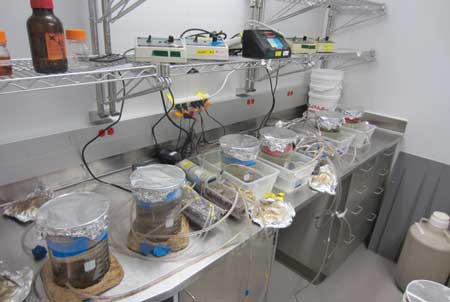| Posted: Feb 16, 2018 |
To untangle the effects of nanoparticles on microbes, look at the genes
(Nanowerk News) The environment is teeming with microbes. Soil, water, indoor surfaces, our own bodies — any habitat that hasn’t been rigorously sterilized is populated by thousands of species of interdependent bacteria, viruses, and other microscopic organisms.
|
|
These webs of microbiota are the biological foundation for larger-scale ecosystems, and small shifts in the microbial community can provoke seismic shifts in the environment.
|
|
Nanoparticles are one of a long list of substances that can perturb them, but teasing out their effects is a Sisyphean task.
|
|
These communities comprise a staggering number of microbes, many of which can’t be grown in the lab — and even if they could, the complex interactions in real-world microbial communities can’t be reproduced by experiments with just a few species.
|
|
In a new paper in the journal Nature Nanotechnology ("Metagenomic analysis of microbial communities yields insight into impacts of nanoparticle design"), researchers from Virginia Tech demonstrate one way to investigate the effect of nanoparticles on a particular microbiome: looking at the DNA of an entire microbial community rather than at individual species.
|
 |
| In these reactors, designed to act like miniature wastewater treatment plants, thousands of species of microbes work together to break down pollutants. Nanoparticles can shift the balance, according to a new study. (Image: Virginia Tech)
|
|
The strategy, called metagenomic analysis, sequences the DNA from all the microbes in a sample at once, yielding an overview of all the genes that are functioning in that environment.
|
|
The results suggest that it’s a useful tool, sensitive enough to catch changes other methods might miss — including some that may have implications for public health.
|
|
Leading the team were Amy Pruden, the W. Thomas Rice Professor of Engineering, and civil and environmental engineering professor Peter Vikesland. Both are experts on complex environmental systems; Pruden studies the roles of dynamic microbial communities and Vikesland currently focuses on the impacts of nanotechnology on the environment.
|
|
In this study, the researchers looked at activated sludge microbial communities, which populate wastewater treatment plants and break down pollutants in sewage.
|
|
“We’re using real-world, complex communities, ones that are important environmentally because they’re purifying our water,” Pruden said.
|
|
Nanoparticles are increasingly common in wastewater, washed in from a growing list of products that includes everything from marshmallows to medical equipment.
|
|
The nanoparticles used in the study were gold spheres and rods synthesized in the lab of Catherine Murphy, a professor of chemistry at the University of Illinois at Urbana-Champaign. The research team introduced these nanoparticles into a laboratory-scale reactor that simulates a wastewater treatment plant, and ran a metagenomics analysis after seven days and another after 56 days.
|
|
It turned out that the nanoparticles did change the distribution of genes in the activated sludge microbial community, and that spherical nanoparticles had a greater influence than rodlike ones.
|
|
Among the genes affected were those that help infectious bacteria evade antibiotics.
|
|
Wastewater treatment plants have been identified as a reservoir for antibiotic-resistance genes that eventually find their way into the environment, where they present an increasing risk to public health.
|
|
Over eight weeks of exposure to gold nanoparticles, the total number of antibiotic-resistance genes in the sample held steady, but the distribution of those genes — that is, which antibiotics they guard against — shifted. The researchers also noticed changes in genes that allow bacteria to withstand exposure to metals, which are normally cytotoxic.
|
|
Meanwhile, the identity of a chemical coating in the nanoparticles didn’t prompt the same genetic changes.
|
|
“The surprising results of this study — that nanoparticle shape can impact microbial community structure to a greater extent than surface properties imparted by coatings — has significant implications not only to inform the safer design of nanomaterials and mitigate unintended impacts to ecosystem and public health, but also to prepare wastewater treatment plants for a potential, relatively overlooked growing challenge,” said Pedro Alvarez, the George R. Brown Professor of Civil and Environmental Engineering at Rice University.
|
|
Alvarez studies the environmental applications and implications of nanotechnology, but was not involved in this research.
|
|
The coating on the nanoparticles did, however, affect their distribution between the sludge and the wastewater. That can have environmental consequences: the sludge in a wastewater treatment plant is recycled and used again, while the water is released back into the environment.
|
|
But neither the nanoparticles’ shifting location nor the microbes’ genetic changes seemed to affect efficiency at breaking down pollutants. That highlights the sensitivity of this metagenomics approach: that it may be able to catch subtle shifts in a community before they can be picked up by simpler measures, like the performance of a wastewater treatment plant.
|
|
“It’s like a microbial canary in the coal mine,” Vikesland said.
|
|
Pruden and Vikesland stress that much more research is necessary to understand how different types of nanoparticles affect microbial communities, and that it’s not clear whether the changes they saw in antibiotic-resistance genes are ones that would pose a risk to public health.
|
|
“We’re collaborating with professors in computer science to take this metagenomics risk assessment approach to the next level,” Pruden said. They’re working on creating a tool that could help assess which genetic changes might be problematic.
|
|
The key conclusion, the researchers say, is that these results suggest that metagenomics analysis can provide valuable information about the effects of nanoparticles on a complex microbial ecosystem.
|
|
“The metagenomics are saying that there is a signal,” Vikesland said. “Right now we don’t know what the real-world implications of that signal are, but there’s clearly something there.”
|

